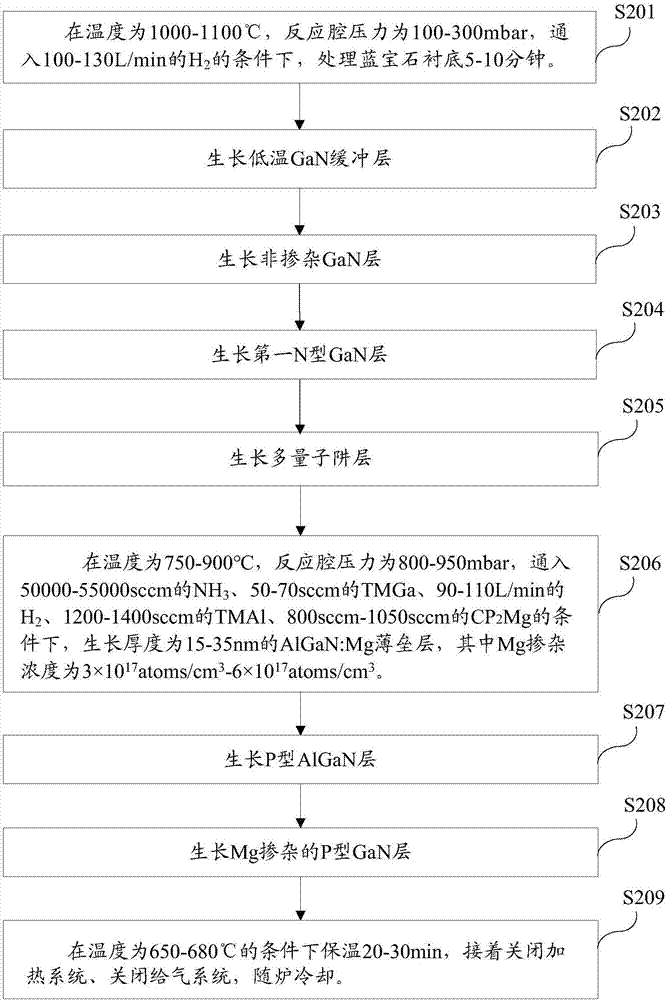LED epitaxial growth method capable of enhancing internal quantum efficiency
A technology of internal quantum efficiency and epitaxial growth, which is applied in the field of LED epitaxial growth to improve internal quantum efficiency, can solve problems affecting LED luminous efficiency, achieve the goal of suppressing electron leakage current, increasing the number of electron-hole pairs, and enhancing luminous radiation efficiency Effect
- Summary
- Abstract
- Description
- Claims
- Application Information
AI Technical Summary
Problems solved by technology
Method used
Image
Examples
Embodiment 1
[0052] This embodiment provides an LED epitaxial growth method for improving internal quantum efficiency, figure 1 A schematic structural diagram of the LED epitaxy prepared by the LED epitaxy growth method in this embodiment is given, please refer to figure 1 , the LED epitaxy, including: a low-temperature GaN buffer layer 102, a non-doped GaN layer 103, an N-type GaN layer 104, a multi-quantum well layer 105, an AlGaN:Mg thin barrier layer 106, a P Type AlGaN layer 107 and P-type GaN layer 108. Wherein, the N-type GaN layer 104 includes a first N-type GaN layer 1041 and a second N-type GaN layer 1042; the multi-quantum well layer 105 includes alternately grown In x Ga (1-x) The alternating period of the N well layer 1051 and the GaN barrier layer 1052 is controlled at 7-15.
[0053] The LED epitaxial growth method for improving the internal quantum efficiency provided by this embodiment, figure 2 The flow chart of the LED epitaxial growth method for improving the intern...
Embodiment 2
[0065] This embodiment provides an LED epitaxial growth method for improving internal quantum efficiency, image 3 A schematic structural diagram of the LED epitaxy prepared by the LED epitaxy growth method in this embodiment is given, please refer to image 3 , the LED epitaxy, including: a low-temperature GaN buffer layer 302, a non-doped GaN layer 303, an N-type GaN layer 304, a multi-quantum well layer 305, an AlGaN:Mg thin barrier layer 306, a P Type AlGaN layer 307 and P-type GaN layer 308. Wherein, the N-type GaN layer 304 includes a first N-type GaN layer 3041 and a second N-type GaN layer 3042; the multi-quantum well layer 305 includes alternately grown In x Ga (1-x) The alternating period of the N well layer 3051 and the GaN barrier layer 3052 is controlled at 7-15.
[0066] The LED epitaxial growth method for improving the internal quantum efficiency provided by this embodiment, Figure 4 The flow chart of the LED epitaxial growth method for improving the intern...
PUM
 Login to View More
Login to View More Abstract
Description
Claims
Application Information
 Login to View More
Login to View More - Generate Ideas
- Intellectual Property
- Life Sciences
- Materials
- Tech Scout
- Unparalleled Data Quality
- Higher Quality Content
- 60% Fewer Hallucinations
Browse by: Latest US Patents, China's latest patents, Technical Efficacy Thesaurus, Application Domain, Technology Topic, Popular Technical Reports.
© 2025 PatSnap. All rights reserved.Legal|Privacy policy|Modern Slavery Act Transparency Statement|Sitemap|About US| Contact US: help@patsnap.com



